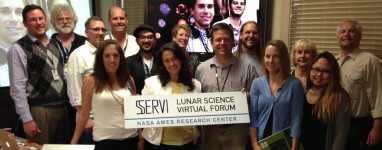Having lived in Hilo for the last couple of years, and on the Big Island for over four years now, it is a bit saddening that I have never bothered to become a member of the
Imiloa Astronomy Center nor really attend many of the awesome events they regularly put on. Today, however, I had the opportunity to change that by attending an
interesting talk by
Ryan Lau, a graduate student out of Cornell University and a native Hawaiian resident, discussing his graduate work with infrared astronomy aboard NASA's
SOFIA, a modified 747 designed to operate at 45,000 feet.
 |
| One of SOFIA's recent flight plans |
Lau did a really great job of giving a brief overview of his work and of infrared astronomy in general, opening with an anecdote about his realization that the
Sagan Walk, which originates at Cornell University, has the
final piece of installation - representing the nearest star to our sun, Alpha Centauri - right here at the Imiloa Center, a project just completed this last December. As I reflect on it afterward, it is interesting to me that his diagram of the Sagan Walk, with the diagram arrows stretching nearly 8000km across the United States, ended up looking similar in spirit to his later slide depicting the flight paths taken by SOFIA as it flies across the United States. The contrast, of course, being that while we have mastered the ability to fly ourselves easily across our own globe, the thought of travelling to our nearest star, let alone something like the galactic center, still remains as daunting of a concept as the flat world was to initial explorers.
Any talk that is given to the general public about a highly advanced and specialized subject necessarily skips over a lot of the details but I thought that Lau did a really good job both in his presenting style, his ability to answer questions, and in his overall format of the speech. As he highlighted in the beginning, he wanted listeners to come away from the hour with three key points:
- Infrared is awesome.
- Airborne astronomy is awesome.
- The galactic center is awesome.
 |
| A look inside SOFIA. Lau is in bottom left. |
With that in mind, Lau guided us through a brief but thorough overview of infrared astronomy, including the current ground and space based systems (
R.I.P. Herschel) as well as the problems associated with each, with atmospheric conditions mostly affecting the former and prohibitive cost/effectiveness the latter. So onward to the second key point, that of airbone astronomy and SOFIA.
There is literature out there (follow the links above) describing SOFIA so I won't go into too much detail other than to say that it appears to be a pretty cool setup. Flight times are typically on the order of 10 hours, with nearly 5 hours of science accomplished on each flight. A typical session will last about 3 weeks, with 2-3 flights happening each week, for a total of 10-15 flights per session. The latest session, which Lau was on the plane for, had ended the previous week and had included some exciting new images of the galactic center, which is the thrust of Lau's work and his third key point.
 |
| The Galactic Center is Awesome |
Specifically, Lau has been using the Faint Object Infrared Camera for the SOFIA Telescope (FORCAST - playing fast and loose with acronyms) to look at two main regions of the galactic center, that of the inner 10 light years and the gaseous torus of dust that surrounds the black hole there, as well as that of The Sickle, which is a dense region of recent massive star formation and the site of three identified
Luminous Blue Variables, extremely bright stars that can undergo unpredictable and radical shifts in brightness and spectra. In addition to being extremely bright, these stars are also extremely rare, with only 20 of them having ever been confirmed. To have three of them in one area of focus is quite extraordinary and the latest pictures generated by Lau also showed some pretty exciting properties that have never been observed.
One of the really fascinating things for me when I see stuff like this is that the science is a work in progress. Lau had literally taken these images last week and revealed some pretty incredible and awesome pictures of the two focus areas - images which aren't released to the public yet - and is still in the active process of interpreting and analyzing the results. While I would love to spill the beans on this by talking about these cool properties, I'll go ahead and wait until Lau has published his work before highlighting anything. Needless to say I thought it was pretty cool.
As mentioned, Lau did a good job of explaining these concepts and some of his results and overall just did a really thorough and concise job of giving a run-down of his recent work. Thanks again to Ryan Lau and the Imiloa Astronomy Center for the opportunity.










